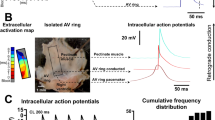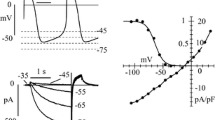Abstract
The sinoatrial node, or sinus node, of humans is the principal pacemaker of the heart. Over the last century, studies have unraveled the complex molecular architecture of the sinus node and the expression of unique ion channels within its specialized myocytes. Aim of this review is to describe the embriology, the anatomy, the histology and the electrophisiology of the sinus node.





Similar content being viewed by others
References
Keith, A., & Flack, M. (1907). The form and nature of the muscular connections between the primary divisions of the vertebrate heart. Journal of Anatomy and Physiology, 41, 172–189.
Lewis, T. (1910). Galvanometric curves yielded by cardiac beats generated in various areas of the auricular musculature: the pacemaker of the heart. Heart, 2, 23–46.
Hoogaars, W. M., Engel, A., Brons, J. F., Verkerk, A. O., De Lange, F. J., Wong, L. Y., Bakker, M. L., et al. (2007). Tbx3 controls the sinoatrial node gene program and imposes pacemaker function on the atria. Genes and Development, 21, 1098–1112.
Hoogaars, W. M., Tessari, A., Moorman, A. F., De Boer, P. A., Hagoort, J., Soufan, A. T., Campione, M., et al. (2004). The transcriptional repressor Tbx3 delineates the developing central conduction system of the heart. Cardiovascular Research, 62, 489–499.
Truex, R. C., Smythe, M. Q., & Taylor, M. J. (1967). Reconstruction of the human sinoatrial node. Anatomical Record, 159, 371–378.
Sanchez-Quintana, D., Cabrera, J. A., Farre, J., Climent, V., Anderson, R. H., & Ho, S. Y. (2007). Sinus node revisited in the era of electroanatomical mapping and catheter ablation. Heart, 91, 189–194.
Lee, R. J., Kalman, J. M., Fitzpatrick, A. P., Epstein, L. M., Fisher, W. G., Olgin, J. E., Lesh, M. D., et al. (1995). Radiofrequency catheter modification of the sinus node for “inappropriate” sinus tachycardia. Circulation, 92, 2919–2928.
Anderson, K. R., Ho, S. Y., & Anderson, R. H. (1979). Location and vascular supply of sinus node in human heart. British Heart Journal, 41, 28–32.
Hudson, R. E. B. (1960). The human pacemaker and its pathology. British Heart Journal, 22, 153–156.
James, T. N., Sherf, L., Fine, G., & Morales, A. R. (1966). Comparative ultrastructure of the sinus node in man and dog. Circulation, 34, 139–163.
Anderson, R. H., & Ho, S. Y. (1998). The architecture of the sinus node, the atrioventricular conduction axis, and the internal atrial myocardium. Journal of Cardiovascular Electrophysiology, 9, 1233–1248.
Chandler, N. J., Greener, I. D., Tellez, J. O., Inada, S., Musa, H., Molenaar, P., Difrancesco, D., et al. (2009). Molecular architecture of the human sinus node: insights into the function of the cardiac pacemaker. Circulation, 119, 1562–1575.
Watanabe, E., Honjo, H., Anno, T., et al. (1995). Modulation of pacemaker activity of sinoatrial node cells by electrical load imposed by an atrial cell model. American Journal of Physiology, 269, H1735–H1742.
Anumonwo, J. M. B., Jalife, J., Zipes, D. P. (1995). Cellular and subcellular mechanisms of pacemaker activity initiation and synchronization in the heart. Cardiac electrophysiology: from cell to bedside. Philadelphia: Saunders.
Fedorov, V. V., Schussler, R. B., Hemphill, M., et al. (2009). Structural and functional evidence for discrete exit pathways that connect the canine sinoatrial node and atria. Circulation Research, 104, 915–923.
Boyett, M. R., Inada, S., Yoo, S., Li, J., Liu, J., Tellez, J., Greener, I. D., et al. (2006). Connexins in the sinoatrial and atrioventricular nodes. Advances in Cardiology, 42, 175–197.
Fahrenback, J., Mejia-Alvarez, R., & Banach, K. (2007). The relevance of non-excitable cells for cardiac pacemaker function. Journal of Physiology, 585(2), 565–578.
Alings, A. M., Abbas, R. F., & Bouman, L. N. (1993). Age-related changes in structure and relative collagen content of the human and feline sinoatrial node. A comparative study. European Heart Journal, 14, 1278–1288.
Demoulin, J. C., & Kulbertus, H. E. (1978). Histopathological correlates of sinoatrial disease. British Heart Journal, 40, 1384–1389.
Schuessler, R. B., Boineau, J. P., & Bromberg, B. I. (1996). Origin of the sinus impulse. Journal of Cardiovascular Electrophysiology, 7, 263–274.
Dilaveris, P. E., Farborn, P., Batchvarov, V., Ghuran, A., & Malik, M. (2001). Circadian behavior of P-wave duration, P-wave area and PR interval in healthy subjects. Annals of Noninvasive Electrocardiology, 6, 92–97.
Busquet, J., Fontan, F., Anderson, R. H., et al. (1984). The surgical significance of the atrial branches of the coronary arteries. International Journal of Cardiology, 6, 223–234.
Crick, S. J., Sheppard, M. N., Ho, S. Y., & Anderson, R. H. (1999). Localisation and quantitation of autonomic innervation in the porcine heart I: conduction system. Journal of Anatomy, 195, 341–357.
Crick, S. J., Wharton, J., Sheppard, M. N., et al. (1994). Innervation of the human cardiac conduction system. A quantitative immunohistochemical and histochemical study. Circulation, 89, 1697–1708.
Uijtdehaage, S. H., & Thayer, J. F. (2000). Accentuated antagonism in the control of human heart rate. Clinical Autonomic Research, 10(3), 107–110.
Robinson, R. B., & Difrancesco, D. (2001). Sinoatrial node and impulse initiation. In P. Spooner & M. Rosen (Eds.), Foundations of cardiac arrhythmias: basic concepts and clinical approaches. New York: Marcel Dekker.
Vassalle, M., Yu, H., Cohen, I. S., Zipes, D. P., Jalife, J. (1995). Pacemaker channels and cardiac automaticity. Cardiac electrophysiology: from cell to bedside. Philadelphia: Saunders.
Bleeker, W. K., MacKaay, A. J. C., Masson-Pevet, M., et al. (1980). Functional and morphologic organization of the rabbit sinus node. Circulation Research, 46, 11–22.
West, T. C. (1955). Ultramicroelectrode recording from the cardiac pacemaker. Journal of Pharmacology and Experimental Therapeutics, 115, 283–290.
Bozler, E. (1943). The initation of impulses in cardiac muscle. American Journal of Physiology, 138, 273–282.
Maltsev, V. A., & Lakatta, E. G. (2008). Dynamic interactions of an intracellular Ca2+ clock and membrane ion channel clock underlie robust initiation and regulation of cardiac pacemaker function. Cardiovascular Research, 77, 274–284.
Maltsev, V. A., & Lakatta, E. G. (2007). Normal heart rhythm is initiated and regulated by an intracellular calcium clock within pacemaker cells. Heart, Lung & Circulation, 16(5), 335–348.
Monfredi, O., Maltsev, V. A., & Lakatta, E. G. (2013). Modern concepts concerning the origin of the heartbeat. Physiology, 28, 74–92.
DiFrancesco, D., & Borer, J. (2007). The funny current: cellular basis for the control of heart rate. Drugs, 67(Suppl 2), 15–24.
Shibata, E. F., & Giles, W. R. (1985). Ionic currents that generate the spontaneous diastolic depolarization in individual cardiac pacemaker cells. Proceedings of the National Academy of Sciences of the United States of America, 82, 7796–7800.
Irisawa, H., Brown, H. F., & Giles, W. (1993). Cardiac pacemaking in the sinoatrial node. Physiological Reviews, 73, 197–227.
Dobrzynski, H., Boyett, M. R., & Anderson, R. H. (2007). New insights into pacemaker activity: promoting understanding of sick sinus syndrome. Circulation, 115, 1921–1932.
DiFrancesco, D. (1981). A new interpretation of the pace-maker current in calf Purkinje fibres. Journal of Physiology, 314, 359–376.
Verkerk, A., Wilders, R., van Borren, M. M., et al. (2007). Pacemaker current (If) in the human sinoatrial node. European Heart Journal, 28, 2472–2478.
Nof, E., Luria, D., Brass, D., et al. (2007). Point mutation in the HCN4 cardiac ion channel pore affecting synthesis, trafficking, and functional expression is associated with familial asymptomatic sinus bradycardia. Circulation, 116, 463–470.
Bucchi, A., Barbuti, A., Baruscotti, M., & DiFrancesco, D. (2007). Heart rate reduction via selective ‘funny’ channel blockers. Current Opinion in Pharmacology, 7, 208–213.
Wainger, B. J., DeGennaro, M., Santoro, B., Siegelbaum, S. A., & Tibbs, G. R. (2001). Molecular mechanism of cAMP modulation of HCN pacemaker channels. Nature, 411, 805–810.
Noble, D., Denyer, J. C., Brown, H. F., & DiFrancesco, D. (1992). Reciprocal role of the inward currents ib, Na and if in controlling and stabilizing pacemaker frequency of rabbit sino-atrial node cells. Proceedings of the Royal Society of London B: Biological Sciences, 250, 199–207.
Lombardi, F., Makikallio, T. H., Myerburg, R. J., & Huikuri, H. V. (2001). Sudden cardiac death: role of heart rate variability to identify patients at risk. Cardiovascular Research, 50, 210–217.
Kodama, I., Nikmaram, M. R., Boyett, M. R., Suzuki, R., Honjo, H., & Owen, J. M. (1997). Regional differences in the role of the Ca2+ and Na+ currents in pacemaker activity in the sinoatrial node. American Journal of Physiology, 272, H2793–H2806.
Hagiwara, N., Irisawa, H., & Kameyama, M. (1988). Contribution of two types of calcium currents to the pacemaker potentials of rabbit sino-atrial node cells. Journal of Physiology, 395, 233–253.
Bogdano, K. Y., Vinogradova, T. M., & Lakatta, E. G. (2001). Sinoatrial nodal cell ryanodine receptor and Na+-Ca2+ exchanger: molecular partners in pacemaker regulation. Circulation Research, 88, 1254–1258.
Ju, Y. K., Chu, Y., Chaulet, H., Lai, D., Gervasio, O. L., Graham, R. M., Cannell, M. B., et al. (2007). Store-operated Ca2+ influx and expression of TRPC genes in mouse sinoatrial node. Circulation Research, 100, 1605–1614.
Author information
Authors and Affiliations
Corresponding author
Rights and permissions
About this article
Cite this article
Murphy, C., Lazzara, R. Current concepts of anatomy and electrophysiology of the sinus node. J Interv Card Electrophysiol 46, 9–18 (2016). https://doi.org/10.1007/s10840-016-0137-2
Received:
Accepted:
Published:
Issue Date:
DOI: https://doi.org/10.1007/s10840-016-0137-2




